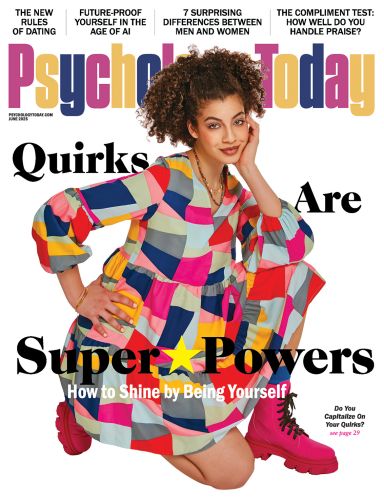Creativity
Creativity, Social Bonds, and Brain Opioid Theory
Exploring the oscillating jeong and haan of Vincent van Gogh
Posted April 4, 2025 Reviewed by Davia Sills
Key points
- Korean concepts of jeong (social connectedness) and haan (disconnection) can affect creativity.
- Brain opioids support complex integration of a range of signals related to aesthetics and social affiliation.
- Van Gogh's act of self-mutilation could have been connected to his oscillating experience with jeong and haan.
Co-authored by Jessica Del Pozo, Ph.D., and Sung Lee, M.D.
For this article, I teamed up with one of the authors of the paper (“The jeong and haan of Vincent van Gogh: neuropeptides of bondedness and loss”) that I have been drawing from. Together, we paint a new picture of Van Gogh, especially during the months and moments before and after his self-injury in December 1888—which were some of the most productive of his artistic career. Van Gogh’s life and work can serve as a dramatic illustration of the ideas in the previous articles on jeong and haan. Yet before appreciating the Dutch master in a new way, we can first set the stage by considering a likely mechanism for the joy of creative flow.
When have you experienced a state of flow? What were you doing?
The state of flow, made familiar to us by the studies of Mihaly Csikszentmihalyi, occurs when we are so completely immersed and engaged in what we are doing that we have no sense of subject versus objects—there is no thinking or worrying, and time seems to stand still. Intuitively, being in flow also depends on the presence of endorphins and enkephalins. According to the brain opioid theory of stable euphoric creativity (BOTSEC), this subtly pleasurable state likely involves the same homemade neuropeptides that are critical to pain relief and, as noted in Part 1 of this series, social connectedness or jeong.
The mechanisms for brain opioids to facilitate the flow state are not from “direct hits” to the brain’s “pleasure centers.” The activation of opioid receptors—which are very widely distributed in the brain—leads to short-term inhibition of neuronal activity and decreased neurotransmitter release. Neuroscientist Carlee Toddes describes cellular activity as a theater stage. The effects of opioids are “like the set crew, adjusting the tone and impact of a stimulus by calibrating lighting, music, and props so as to convey and highlight meanings… opioids are thus powerful facilitators of emotional and motivational states, helping to fine-tune awareness, thoughts and perceptual patterns, and behavioral output.”
Therefore, brain opioids may support the complex integration of a wider range of signals related to aesthetics and social affiliation. When opioid receptors activate, perhaps perception itself slows down, and in that process, we can perceive “more,” and the net effect is that more of what we perceive can be a source of pleasure; and indeed, perhaps when we are feeling bathed in jeong, everything looks beautiful—because everything is beautiful in some aspect or another.
Together, the endorphin theory of jeong and the BOTSEC can explain much about the mutual benefits of community and creativity. Brain opioids for jeong and flow states can reinforce one another in a virtuous cycle. Conversely, if the sense of community is weak for anyone whose work is highly dependent on creativity, they may be more vulnerable to the inevitable emotional dips that accompany the coming and going of flow. Armed with these insights, we can look through new eyes at that great pioneer of expressionism who embraced intensity in emotional experience, created a new poetry of color, felt deep jeong for the subjects of his paintings, and was able to overcome—to some degree—toxic levels of haan (disconnection) in order to realize his artistic visions.
Jeong, haan, and Vincent Van Gogh
To more fully understand what happened at Van Gogh’s Yellow House in Arles, France, on December 23, 1888, one could go as far back as Dutch national haan over their historical subjugation to Spanish rule, or the Van Gogh family’s haan at being sent to minister to scattered Protestants in a backwater region of Holland populated mostly by Catholics, or Vincent’s personal haan at being treated as an odd, barely lovable child by his propriety-minded, class-conscious family. In the Spring of 1888, Vincent was overjoyed—his jeong perhaps crescendoing in anticipation at the prospect of the feted artist Paul Gauguin joining him in the South of France at a home that he hoped would further blossom into an artist’s colony.
We theorize that Van Gogh’s brain opioids may have been increasing to new levels as he eagerly organized their respective bedrooms and zealously painted in the beautiful plain air settings that he found on long walks with his easel and palette. And when Gauguin did arrive, endorphins and enkephalins may have peaked and plateaued for weeks, during a honeymoon period.
Yet, Vincent’s intense personality may have been difficult for the older, more worldly, and already successful Frenchman. When, after less than two months, Gauguin began making plans to leave him, Van Gogh’s jeong would have been replaced by haan of a whole new reciprocal intensity: endorphins plunging and vasopressin perhaps spiking, which turned aggressive. And it may only have been his strong moral instinct that made Vincent turn the razor on himself rather than on the roommate who, in his own mind, was betraying and abandoning him.
Though this narrative is unsettling, Van Gogh’s self-mutilation may have started a chain of events: boosting brain opioids for pain relief, imbibing new jeong at the hospital where he received innovative care from the staff that jump-started flow states for whole new kinds of creativity after this painful experience. In the two years after his injury, Vincent painted some 290 works, including his Irises, Starry Night, and Wheatfield with Cypresses, which are among the most memorable. While some level of suffering (haan) may be part of life, hopefully, it is not a necessary component of producing exceptional creative work. How can creators—and we are all creators—generate work without engaging in self-harm, including harsh criticism, self-judgment, or sabotage?
Jeong is a natural answer, and here we come full circle to the point we made at the beginning: Community itself and healthy relationship connections are essential for living a good life—one filled with innovation and flow. The pain of haan may play a role, but a healthy jeong is fundamental.
In our next and final post on jeong, haan, and brain opioids, we will explore a few other health phenomena and share an illustration of the notion that jeong and creative flow can reinforce one another in a virtuous cycle.
References
Lee, S. W., Cullen, K. R., Rim, S. R., & Toddes, C. (2024). The jeong and haan of Vincent van Gogh: neuropeptides of bondedness and loss. Frontiers in psychology, 15, 1432175. https://doi.org/10.3389/fpsyg.2024.1432175






